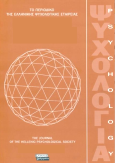Learning to spell in Greek: strategies used in spelling by first graders
Abstract
The purpose of the present study was to explore spelling development and spelling strategies employed by novice Greek spellers. Overall, 50 children were assessed throughout the first year of schooling in three testing sessions (Phase 1: November - December, Phase 2: February - March, Phase 3: May-June). The study was based on error measurements of spelling-to-dictation of isolated words. Spelling accuracy was calculated in terms of both phonologically and orthographically correct outputs. The material chosen were 72 words (with or without multi-letter graphemes) from the basic vocabulary of the language textbooks for primary school pupils of Grade A. The
results are generally consistent with the view that at the initial phases children mainly utilize phonological knowledge of phoneme-grapheme correspondences when spelling, while at the end of Primary A they begin
to employ mnemonic strategies in spelling.
Article Details
- How to Cite
-
Σαρρής Μ., & Πόρποδας Κ. (2020). Learning to spell in Greek: strategies used in spelling by first graders. Psychology: The Journal of the Hellenic Psychological Society, 19(4), 373–397. https://doi.org/10.12681/psy_hps.23696
- Issue
- Vol. 19 No. 4 (2012)
- Section
- RESEARCH PAPERS

This work is licensed under a Creative Commons Attribution-ShareAlike 4.0 International License.
The journal PSYCHOLOGY adopts a Platinum open-access policy. Submission, processing or publication costs are waived by the Hellenic Psychological Society. Papers published in the journal PSYCHOLOGY are licensed under a 'Creative Commons Attribution-ShareAlike 4.0 International' licence. The authors reserve the copyright of their work and grant the journal the right of its first publication. Third-party licensees are allowed to use the published paper immediately after publication as they wish, provided they retain the defined by the license copyright formalities, regarding the reference to its author(s) and its initial publication in the journal PSYCHOLOGY. Moreover, any adjusted work should be shared under the same reuse rights, so with the same CC license.




